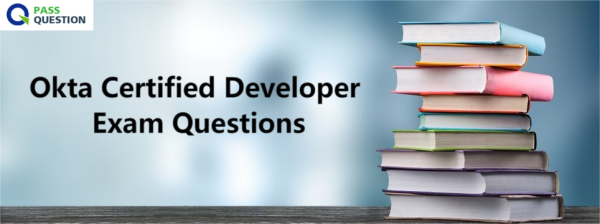Okta Certified Developer Exam Questions
PassQuestion Okta Certified Developer Exam Questions are designed to help you prepare for the Okta Developer Certification Exam. Passing this exam is a requirement for becoming an Okta Certified Developer. Our Okta Certified Developer Exam Questions will provide you with real exam questions with verified test answers that reflect the actual Okta Certified Developer exam. Okta Certified Developer Exam Questions consist of reliable questions and answers which are sufficient enough to facilitate candidates in preparing for Okta Certified Developer exam.

Okta Certified Developer
Okta Certified Developers are technically proficient at building secure, seamless experiences using Okta APIs and SDKs. Developers have experience working with RESTful APIs and developing web applications. They have general understanding of authentication and authorization standards such as OpenID Connect (OIDC) and OAuth, as well as how Okta supports these standards for building authentication, flexible authorization, and role-base access control. Developers also have experience configuring authorization with API Access Management and implementing Single Sign-On (SSO) with OIDC. They have working knowledge of Okta Lifecycle Management and administrative APIs.
About the Okta Certified Developer Exam
This exam has two parts.
• Part I: 45 Discrete Option Multiple Choice Questions
• Part II: Four Performance-Based, Hands-on Use Cases
Exam takers complete Part I and then are permitted to start Part II.
Exam takers are not permitted to return to Part I after they have completed it and submitted their responses for grading.
Time allotted: Part I: 60 minutes, Part II: 90 minutes
IMPORTANT:
• Each part is timed separately. Any time left over from Part I does NOT carry over to Part II.
• Because this is a two-hour and 30 minutes exam, come fully prepared to sit through the entire exam. There is no break between parts I and II of this exam.
Exam fee: USD 250 (USD 100 for each subsequent retake)
Format: Part I of this exam includes Discrete Option Multiple-Choice (DOMC) items. Part II contains performance-based, hands-on use cases.
Okta Certified Developer Exam Subject Areas
Part I
Authentication 9%
Compare and Evaluate Authentication Methods
Understand Methods for Creating an Okta Session
SSO and API Access Management with OIDC and OAuth 18%
Enable an OAuth Client Application to Securely Access Services
Describe client types and flows
Optimize the API consumption
Lifecycle Management 16%
Use the Core API to Manage Users
User Objects, User States, and User Profile Sourcing
Use the Core API - Groups
Just-in-Time Provisioning (JIT)
Administrative APIs 20%
Use the Core API - Schemas
Use the Core API - Policy
Use the Core API - Factors
Use the Core API - OAuth
Use the Core API - Apps
Debug Techniques 9%
Debug API-Related Issues
Debug API Requests
Design Principles 18%
Apply the Okta API Design Principles
Okta API Rate Limiting
Redirect or CORS as Trusted Origin
App Logout and Global Logout
Okta Hooks 9%
Inline Hooks
Event Hooks
Working with the Sign-In widget for Authentication 2%
Okta Sign-in Widget Customization and Configuration
Part II
Onboard new users using Okta’s Management SDK and User and Group APIs 27%
Manage users with Okta’s Management SDK and User and Group APIs
Federate an App through OIDC 33%
Provide federated access to an app using OIDC
Display claim data from the ID token
Securing an API using OAuth and Securely accessing an API from a client app using OAuth 20%
Secure an API using OAuth by verifying there is a valid bearer of token
Securely access API from a client application using OAuth in Okta
Implement the Okta Sign-In Widget for Authentication Purposes 20%
Implement a custom authentication experience with the Okta Sign-In Widget
Implement and enforce multifactor authentication
Create a session for a user
View Online Okta Certified Developer Exam Free Questions
When using Okta as an authorization server:
A. You can set the audience to the preferred custom service you'll use
B. The audience is always set to Okta org itself
C. You cannot set the audience
D. You cannot set the audience as it can only be used with the Okta org in the userinfo request to get the user claims
Answer: B, C, D
Which of the following Oauth 2.0 flow(s) supports Access Tokens?
A. Authorization Code
B. Authorization Code with PKCE
C. Implicit
D. Resource Owner Password
E. Client Credentials
Answer: A, B, C, D
Which of the following is/ are True?
A. The Authorization Code flow with PKCE doesn't support Refresh Tokens for SPAs
B. The Authorization Code flow with PKCE doesn't support Refresh tokens for browser-based apps
C. The PKCE-enhanced Authorization Code flow will require your application to generate a cryptographically random key called a "code verifier"
Answer: C
Can you create inOkta some apps which do not actually use any SSOmethod?
A. No,Okta is used only for SSO when speaking about apps
B. Yes, all apps supporting SWA / SCIM
C. Yes, for example an app based on the 'Bookmark App' template in the OIN
Answer: C
The Hashed Password object allows an existing password to be imported into Okta directly from some other store. Okta supports only this , these hashing functions for password import:
A. BCRYPT
B. SHA-512
C. SHA-256
D. SHA1
E. Mp5
F. All of the above
Answer: F
In which format should your endpoint be able to correctly send back information to Okta, so that endpoint ownership can be verified via Verify Event Hook process?
A. XML format
B. SAML Assertion format
C. JSON format
D. YAML format
E. HDD format
Answer: C
- TOP 50 Exam Questions
-
Exam
All copyrights reserved 2025 PassQuestion NETWORK CO.,LIMITED. All Rights Reserved.

